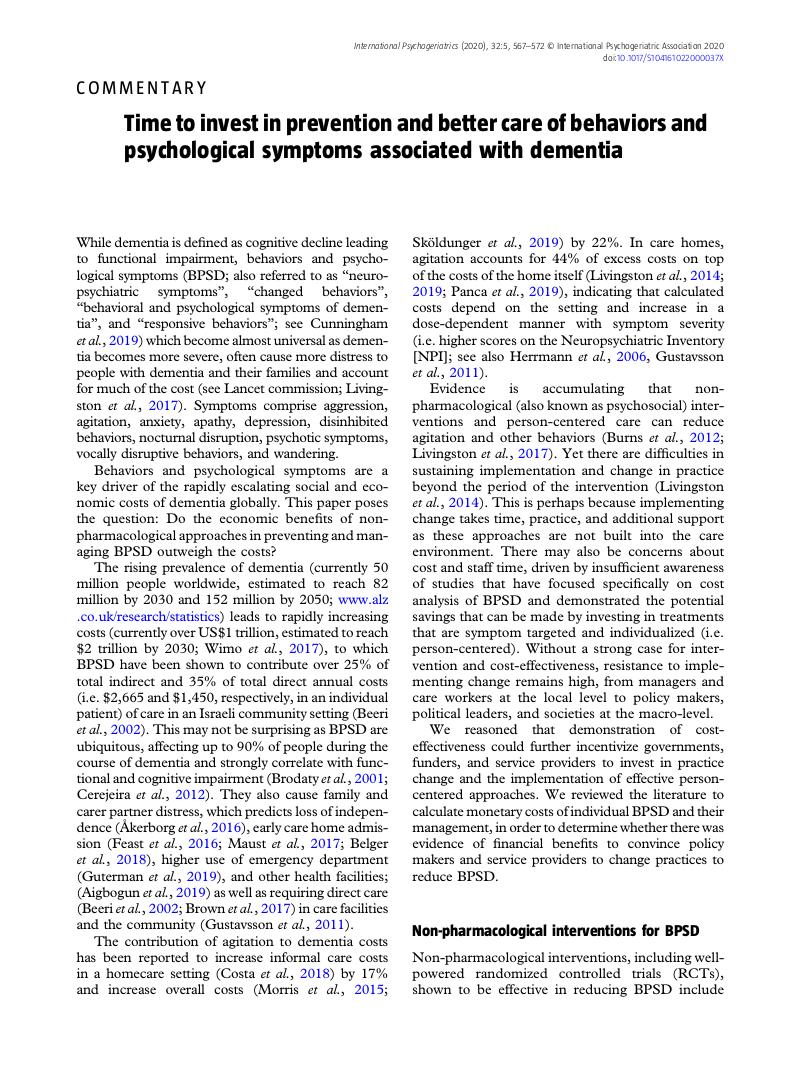Crossref Citations
This article has been cited by the following publications. This list is generated based on data provided by Crossref.
Burley, Claire V.
Casey, Anne-Nicole
Chenoweth, Lynn
and
Brodaty, Henry
2021.
Reconceptualising Behavioral and Psychological Symptoms of Dementia: Views of People Living With Dementia and Families/Care Partners.
Frontiers in Psychiatry,
Vol. 12,
Issue. ,
Williamson, Lesley E.
Evans, Catherine J.
Cripps, Rachel L.
Leniz, Javiera
Yorganci, Emel
and
Sleeman, Katherine E.
2021.
Factors Associated With Emergency Department Visits by People With Dementia Near the End of Life: A Systematic Review.
Journal of the American Medical Directors Association,
Vol. 22,
Issue. 10,
p.
2046.
Kenning, Gail
and
Visser, Mandy
2021.
Evaluating quality of life and well-being at the intersection of dementia care and creative engagement.
Dementia,
Vol. 20,
Issue. 7,
p.
2441.
Burley, Claire V.
Burns, Kim
Lam, Ben C.P.
and
Brodaty, Henry
2022.
Nonpharmacological approaches reduce symptoms of depression in dementia: A systematic review and meta-analysis.
Ageing Research Reviews,
Vol. 79,
Issue. ,
p.
101669.
Henderson, Catherine
Knapp, Martin
Stirling, Susan
Shepstone, Lee
High, Juliet
Ballard, Clive
Bentham, Peter
Burns, Alistair
Farina, Nicolas
Fox, Chris
Fountain, Julia
Francis, Paul
Howard, Robert
Leroi, Iracema
Livingston, Gill
Nilforooshan, Ramin
Nurock, Shirley
O’Brien, John T.
Price, Annabel
Swart, Ann Marie
Tabet, Naji
Telling, Tanya
Thomas, Alan J.
and
Banerjee, Sube
2022.
Cost-effectiveness of mirtazapine for agitated behaviors in dementia: findings from a randomized controlled trial.
International Psychogeriatrics,
Vol. 34,
Issue. 10,
p.
905.
Sulatskaya, Anna I.
Rychkov, Georgy N.
Sulatsky, Maksim I.
Mikhailova, Ekaterina V.
Melnikova, Nadezhda M.
Andozhskaya, Veronika S.
Kuznetsova, Irina M.
and
Turoverov, Konstantin K.
2022.
New Evidence on a Distinction between Aβ40 and Aβ42 Amyloids: Thioflavin T Binding Modes, Clustering Tendency, Degradation Resistance, and Cross-Seeding.
International Journal of Molecular Sciences,
Vol. 23,
Issue. 10,
p.
5513.
Seok, Jo Woon
Shin, Jinhee
Kang, Bada
Lee, Hyangkyu
Cho, Eunhee
and
Lee, Kyung Hee
2022.
Non‐pharmacological interventions using information and communication technology for behavioral and psychological symptoms of dementia: A systematic review and meta‐analysis protocol.
Journal of Advanced Nursing,
Vol. 78,
Issue. 1,
p.
282.
Ferreira, Ana Rita
Sá, Andreia
Dias, Claudia Camila
Simões, Mário R.
Abe, Koji
and
Fernandes, Lia
2022.
Neuropsychiatric Symptoms Assessment: Cross-cultural Adaptation and Validation of the Portuguese Abe’s BPSD Score (ABS).
Clinical Gerontologist,
Vol. 45,
Issue. 3,
p.
591.
Chapman, Kimberly R.
and
Spitznagel, Mary Beth
2022.
The need for disinhibition-focused interventions in dementia.
International Psychogeriatrics,
Vol. 34,
Issue. 4,
p.
331.
O’Connor, Claire M. C.
Fisher, Alinka
Cheung, Sau Chi
Caga, Jashelle
and
Piguet, Olivier
2022.
Supporting behaviour change in younger-onset dementia: mapping the needs of family carers in the community.
Aging & Mental Health,
Vol. 26,
Issue. 11,
p.
2252.
Eikelboom, Willem S.
Koch, Jana
Beattie, Elizabeth
Lautenschlager, Nicola T.
Doyle, Colleen
van den Berg, Esther
Papma, Janne M.
Anstey, Kaarin J.
and
Mortby, Moyra E.
2023.
Residential aged care staff perceptions and responses towards neuropsychiatric symptoms: a mixed methods analysis of electronic healthcare records.
Aging & Mental Health,
Vol. 27,
Issue. 2,
p.
243.
Moyle, Wendy
2023.
Grand challenge of maintaining meaningful communication in dementia care.
Frontiers in Dementia,
Vol. 2,
Issue. ,
Resnick, Barbara
Boltz, Marie
Kuzmik, Ashley
Galik, Elizabeth
and
Galvin, James E.
2023.
RELIABILITY AND VALIDITY OF THE NEUROPSYCHIATRIC INVENTORY-QUESTIONNAIRE USING A RASCH ANALYSIS.
Journal of Nursing Measurement,
Vol. 31,
Issue. 1,
p.
44.
Werner, Perla
2023.
Like beauty and contact lenses, the meaning of dementia behavioral changes is in the eyes of the beholder.
International Psychogeriatrics,
Vol. 35,
Issue. 2,
p.
59.
Burley, Claire V.
Casey, Anne-Nicole
Chenoweth, Lynn
and
Brodaty, Henry
2023.
Views of people living with dementia and their families/care partners: helpful and unhelpful responses to behavioral changes.
International Psychogeriatrics,
Vol. 35,
Issue. 2,
p.
77.
Wesson, Jacqueline
du Toit, Sanetta Henrietta Johanna
Wales, Kylie
Gresham, Meredith
Flavin, Theresa
and
Brodaty, Henry
2023.
Australian National Aged Care Classification behaviour assessment and people living with dementia in residential aged care: Inclusive language for reform?.
Australasian Journal on Ageing,
Vol. 42,
Issue. 1,
p.
234.
Banerjee, Sube
Farina, Nicolas
Henderson, Catherine
High, Juliet
Stirling, Susan
Shepstone, Lee
Fountain, Julia
Ballard, Clive
Bentham, Peter
Burns, Alistair
Fox, Chris
Francis, Paul
Howard, Robert
Knapp, Martin
Leroi, Iracema
Livingston, Gill
Nilforooshan, Ramin
Nurock, Shirley
O’Brien, John
Price, Annabel
Thomas, Alan J
Swart, Ann Marie
Telling, Tanya
and
Tabet, Naji
2023.
A pragmatic, multicentre, double-blind, placebo-controlled randomised trial to assess the safety, clinical and cost-effectiveness of mirtazapine and carbamazepine in people with Alzheimer’s disease and agitated behaviours: the HTA-SYMBAD trial.
Health Technology Assessment,
p.
1.
Fisher, Alinka C.
Cheung, Sau C.
O’Connor, Claire M. C.
and
Piguet, Olivier
2023.
The Acceptability and Usefulness of Positive Behaviour Support Education for Family Carers of People With Frontotemporal Dementia: A Pilot Study.
Journal of Geriatric Psychiatry and Neurology,
Vol. 36,
Issue. 1,
p.
73.
Rantsi, Mervi
Kortelainen, Lauri
Hyttinen, Virva
Jyrkkä, Johanna
and
Kankaanpää, Eila
2023.
Trends in the use of psychotropics in older people with dementia: interrupted time series of Finnish clinical guidelines of behavioural and psychological symptoms of dementia.
Age and Ageing,
Vol. 52,
Issue. 6,
Eikelboom, Willem S.
van den Berg, Esther
Coesmans, Michiel
Goudzwaard, Jeannette A.
Koopmanschap, Marc
Lazaar, Najoua
van Bruchem-Visser, Rozemarijn L.
Driesen, Jan J.M.
den Heijer, Tom
Hoogers, Susanne
de Jong, Frank Jan
Mattace-Raso, Francesco
Thomeer, Elsbeth C.
Vrenken, Suzanne
Vroegindeweij, Lilian J.H.M.
Zuidema, Sytse U.
Singleton, Ellen H.
van Swieten, John C.
Ossenkoppele, Rik
Papma, Janne M.
and
de Oliveira, Fabricio Ferreira
2023.
Effects of the DICE Method to Improve Timely Recognition and Treatment of Neuropsychiatric Symptoms in Early Alzheimer’s Disease at the Memory Clinic: The BEAT-IT Study.
Journal of Alzheimer’s Disease,
Vol. 93,
Issue. 4,
p.
1407.



